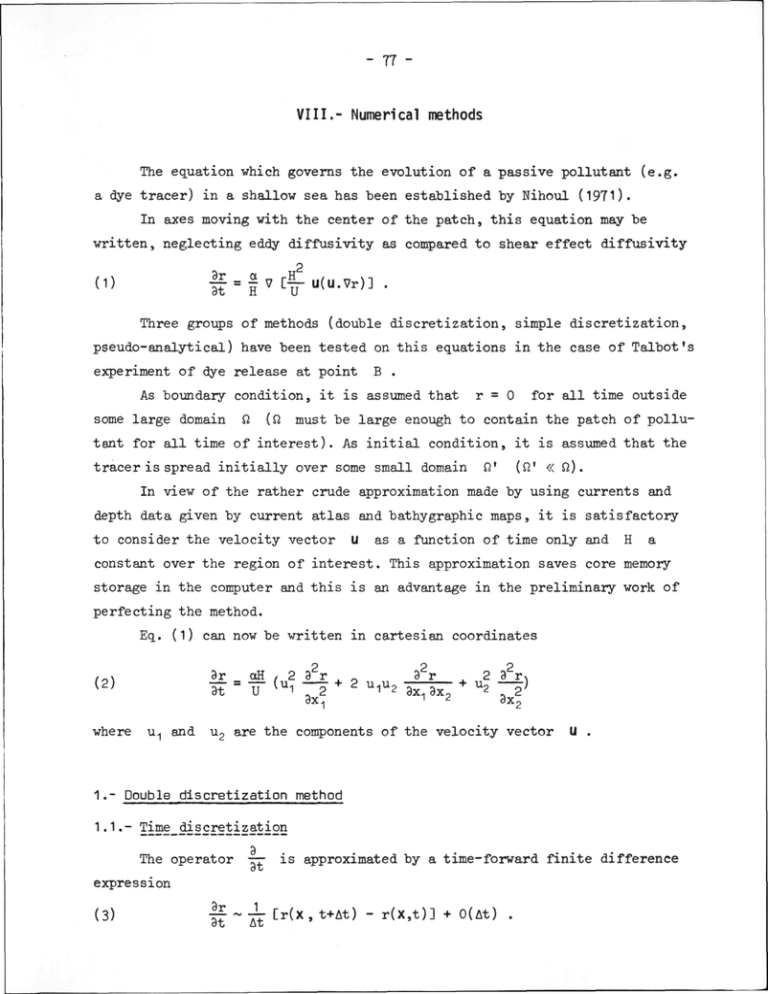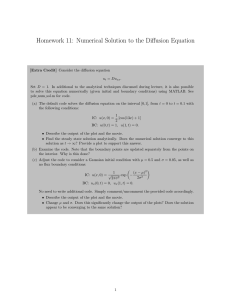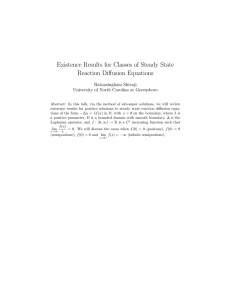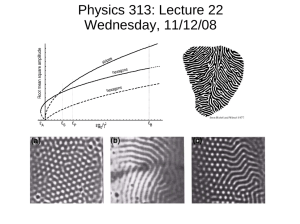- 77 - VIII.- Numerical methods
advertisement

- 77 VIII.- Numerical methods
The equation vhich governs the evolution of a passive pollutant (e.g.
a dye tracer) in a shallow sea has been established by Nihoxil (1971).
In ajces moving with the center of the patch, this equation may be
written, neglecting eddy diffusivity as compared to shear effect diffusivity
(1)
|£ = ^vC^U(U.Vr)] .
Three groups of methods (double d i s c r e t i z a t i o n , simple d i s c r e t i z a t i o n ,
pseudo-analytical) have been t e s t e d on t h i s equations in the case of Talbot's
experiment of dye release at point B .
As boundary condition, i t i s assumed t h a t r = 0 for a l l time outside
some large domain Ci {ü must be large enoiigh to contain the patch of p o l l u t a n t for a l l time of i n t e r e s t ) . As i n i t i a l condition, i t i s assumed t h a t the
t r a c e r i s spread i n i t i a l l y over some small domain ÇI' {Q' « Q).
In view of the rather crude approximation made by using currents and
depth data given by current a t l a s and bathygraphic maps, i t i s s a t i s f a c t o r y
t o consider the velocity vector U as a function of time only and H a
constant over the region of i n t e r e s t . This approximation saves core memory
storage in the computer and t h i s i s an advantage in the preliminary work of
perfecting the method.
Eq. ( l ) can now be written in cartesian coordinates
3r
oH , 2 8^r . „
8^r
. 2 3^rv
9^ = T ^^1 7 2 ^ 2 u^u^ - g - ^ + U2 — )
(2)
where
u^ and
Ug are the components of the velocity vector U
1.- Double d i s c r e t i z a t i o n method
1 . 1 . - Time d i s c r e t i z a t i o n
The operator
-TT i s approximated by a time-forward f i n i t e
at
expression
(3)
It ~ i t ^'^^^ ' **^*^ " ^('^'*)^ * °^^*^ •
difference
- 78 -
2
With symmetric differences, the truncation e r r o r would have been 0(At ) .
However the niomerical s t a b i l i t y analysis shows t h a t in t h i s case the d i f f e rence scheme i s always xmstable. This i s the consequence of the fact t h a t
time appears in a non-symmetric way in equation ( 2 ) . At must be chosen in
order t o minimize the truncation e r r o r without increasing unreasonably the
computation time. In most of our applications
At ~ 600 s .
1.2.- Sgaçe_disçretization
We superpose a n e t - g r i d R^ upon the (x^.x^) plane. This n e t - g r i d
i s square-shaped and the mesh-size i s
i = Ax^ = àx^ ; ^£ i s the subset
of R^ representing the inner points of Q .
The space derivatives are then approximated by the f i n i t e
2
9x2
differences
^
3^
3x^9x2
i.J
- - = ~^ ï^ ï ( ^ i . i , j . i -^ ^ i - i , j - i - ^ i . i , j - i - ^ i-i,i^i ) ^ °(^^)
First, an explicit scheme was tried. In this case, all values
in (k)
are taken at time
r„ „
t . This scheme however did not conserve mass and
negative concentrations were found. Gorenflo (1970) has shown that, under
certain conditions, which are sometimes fulfilled in our problems, there
exist no explicit method giving non negative results everywhere and preserving conservation of mass.
For this reason, an attempt was made to use an implicit scheme. In this
case, values of
pled
r^
linear equations
at time
at
t + At
also occur in (U), Hence simultaneous cou-
(~ UOO) must be solved to compute the concentrations
t + At .
The scheme had however to be abandonned because of non conservation '
[1) Note that eq. (2) is actually parabolic in space (due to the neglecting of eddy diffusivity). Gauss-Seidel method is suitable for elliptic spatial operators describing phenomenons such that each point influences all its neighbours. Now, in parabolic case,
- 79 -
and prohibiti"'e coinputation time.
As t h e solution of the diffusion equation in t h e one-dimensional case
i s the sum of e r r o r functions, i t would seen t h a t a g r i d with meshes e n l a r ging from the origin t o the boundary i s p a r t i c u l a r l y adapted t o
diffusion
problems.
I f we choose
£^-steps
following
£i = «,
£i = i,_,{^
+
6 £ i-1'
L = I Z,
we get a net shown in figure 12,
Finite difference expressions established by Sundquist
h
and Veroins (I9é9) for onedimensional problems make it
h
possible to approximate the
h
spatial operator with a trun-
^1
B
cation error of 0(£. ) , and
h
h
h
to reduce in a significant
way the number of net-points
for the same precision as
constant-step net-grids.
h
But in the two-dimensional
fig. 12.
case, this reduction of memory storage is counterbeilan-
ced by an increasing computation time due to sophisticated formxilas.
On the other hand, this scheme is not conservative, because there is
no symmetry, neither in x^ , nor in Xg , in the expressions of the coefficients.
2.- Simple discretization method (Galerkin method)
The method consists in a conventional time discretization and a decomposition of r(x^,X2,t)
into series of orthonoimed functions
each point influences its neighbours only in a definite direction
fore the Gauss-Seidel method is ill-adapted
(U
ç.(X|^) , i.e.
direction), there-
(no conservation, lateral diffusion).
- 80 -
functions such t h a t :
(6)
I
We write
Ç i ( x , ) Ç j ( x J dXk = s,.
.
r(x^,X2,t) in the following discrete form :
N
(T)
r(x^,X2,t) =
E
a..(t) ^^(x^) Z^U^)
N
,
-'
i,j = 1
being the maximum number of approximation functions for each independent
variable.
(8)
N
(9)
Lr =
where
L
E
i s the spatial
a^.Ct)
Uç^Cx^) Ç-Cxp)]
operator.
Using t h e o r t h o g o n a l i t y p r o p e r t y ( 6 ) , we g e t a l i n e a r system of
N xN
d i f f e r e n t i a l e q u a t i o n s of f i r s t o r d e r which can be s o l v e d by a c l a s s i c a l
Runge-Kutta o r p r e d i c t o r - c o r r e c t o r method, of which w e l l - a d a p t e d v e r s i o n s
exists.
We have t e s t e d t h i s method w i t h two very d i f f e r e n t s e t s of b a s i s
functions.
1 st_set
(10)
Çn(Xk) = cos ( n K x J
K i s choosen such t h a t
c o n d i t i o n s on
n = 1,2,3
cos (K X 10 km) = 0
; k = 1,2
t o s a t i s f y boundary
r . O r t h o g o n a l i t y of t r i g o n o m e t r i c f u n c t i o n s i s well-known.
2nà s e t
X
(11)
where
ç,(Xk) = c , exp ( - Y")
H^(x,^)
H,(Xk)
is the Hermite polynomial of order
n = 1 , . . . , 6 ; k = 1,2
n , with the orthogonality
relation
(12)
J
c^Cj exp (- x^)
Hi(Xk) Hj(x,) dx^^ = 6. . .
- 81 o
The length scale for x^ and
Xg is choosen so that
exp (- x,^)
practically vanishes outside a circle with a diameter of 2 km .
In both cases, properties of approximation functions are such that,
while integrating, terms corresponding to
9x^9x2
v a n i s h and t h e n do not i n f l u e n c e e v o l u t i o n . Thus, t h i s r e p r e s e n t a t i o n
not p e r f e c t l y
is
consistent.
The G a l e r k i n method d i v e r g e s i n b o t h cases a f t e r computations c o r r e s ponding t o a couple hours i n a c t u a l t i m e .
In t h e f i r s t c a s e , i t can be a d m i t t e d t h a t t h e t o t a l number of b a s i s
fimctions i s insufficient t o represent the i n i t i a l concentration
which i s very s h a r p . Moreover, on t h e boundary
distribution,
T , t h e c o n c e n t r a t i o n may
a c t u a l l y v a n i s h , but not i t s s p a t i a l d e r i v a t i v e s , and t h i s f a c t i s p h y s i c a l l y not t r u e .
In t h e second c a s e , t h e i n i t i a l d i s t r i b u t i o n i s w e l l - r e p r e s e n t e d by
the
ç^(x,^)
, t h e s p a t i a l d e r i v a t i v e s of which vanish a t boiindary.
But because t h e
ç^'s
do not vary w i t h t i m e , i t i s i m p o s s i b l e t o
a p p r o x i m a t e , w i t h any a c c u r a c y , t h e smoothing of t h e function
r{x.,X2,t)
in time.
We have had i n mind t o change t h e l e n g t h - s c a l e a t each time s t e p , t o
t a k e smoothing i n t o a c c o u n t , b u t t h i s t e c h n i q u e l e a d s t o very s o p h i s t i c a t e d
problems of connexion between c o n s e c u t i v e s o l u t i o n s and i s of no p r a c t i c a l
interest.
3 . - A n a l y t i c a l methods
3 . 1 . - Pseudo^anal^tical_method
I f we choose the t i m e - s t e p
i s c o n s t a n t . We choose t h e
l r = °"H
9x
small enough, we may admit t h a t
x-axis in the
o n e - d i m e n s i o n a l , with c o n s t a n t
(13)
At
U(t)
U - d i r e c t i o n . So e q . (2) becomes
coefficients.
D= aHu .
- 82 -
If we assume that the initial concentration is
r„ within a range
{-d,+d) , the analytical solution is (Crank) :
r ( x , t ) = I r, [erf ( ^ - ^ )
(li^)
2
+ erf ( ^ - i : ^ ) ]
2 St
^
drawn in figure 131.0
0
C/Co
1 /
\ 4
0.8
2 \\
/ /
1
0.6
"
0.4
^
2
0.2
-IA\
y ^
: : ^
-4
-1
3
4
fig. 13.- Concentration-distance curves for an extended source of limited
extent. Numbers on curves are values of (Dt/£ ) ' .
With t h e former assumptions we can use t h i s s o l u t i o n l o c a l l y , a t each
p o i n t of a n e t - g r i d
tion
r(x^,X2,t)
(x^^jXg)
i f we c o n s i d e r a t each i n s t a n t , t h e c o n c e n t r a -
as an i n i t i a l c o n c e n t r a t i o n t o compute
The problem i s now t o determine f o r each p o i n t
of t h e n e t , which a r e s u f f i c i e n t l y n e a r t o
be i n f l u e n c e d by
r(x.j,X2,t)
r{x^. ,X2.,t+At)
(x^,X2) , t h e p o i n t s
(x^,X2)
in the
.
(x-i.,X2.)
U-direction, to
.
The number of t h e s e p o i n t s i s determined by
(——)
[see figure 1 3 ] .
I
Figure li+ shows t h e choice of t h e s e p o i n t s depending upon t h e d i r e c t i o n of
vector
U i n t h e case where
1 5
u
3 '
u^U2 > 0
U2
and
— > 1
- 83 -
o
i
o
c
o
2
o
o
(p
o
c
"1
o
1
••'
Discrete diffusion
Velocity
fig.
b)
3
o
•" •"-
o
representation
direction
14.
ui
^2
c)
2 < - ^ < It
U'1
i
u . > 1+ .
d)
I t i s easy t o see t h a t a l l s i t u a t i o n s are analogous to one of t h e
formers.
3 . 2 . - Loçal_analytical_solution
If
(15)
9t
^
'
at
'
it can easily be shown that equation (2) has a solution
(16)
-i
r = Ty t
2 1
(ill + i^2)l6 oHt u^
Ug
U
exp
- 8U -
u^ and
Ug being neither constant nor uniform, we co\ild tiy to write the
solution
r(x^,X2,t) in the form
(IT)
r = r K(x^,X2,t)
or
(18)
where
r = ? + K(x^,X2,t)
K
is a continuous and continuously differentiable function of t ,
x^ , X2 , which satisfies a partial differential equation with given boundary conditions
(19)
-~ = N(K,x^,X2,t) .
In t h i s way, we get r i d of the part of the solution t h a t i s the most
d i f f i c u l t t o t r e a t by numerical methods (because of i t s exponential form),
and we may admit that (19) has a smoother solution than ( 2 ) , more accessible
numerically.
This method i s now being i n v e s t i g a t e d .
3.3•~ Isoconcentration_çurves_drawing
We have worked out a routine t o draw isoconcentration curves. This
routine needs, as input data, the values of the concentration at a l l the
points of a n e t - g r i d with constant s t e p .
By means of these data (and interpolation) the routine :
1) computes a l l the points belonging t o the segments of the n e t , where the
concentration i s equal t o a given value (for i n s t a n c e , one t e n t h of the
maximimi concentration) ;
2) s t o r e s the coordinates of these points ( i n i t i a l point i s the origin) ;
3) c l a s s i f i e s and brings together a l l the p o i n t s , mesh after mesh, taking
i n t o account that the concentration inside a curve i s always greater than
the given value on the curve (the curves are assumed t o have a general
convex shape) ;
k) draws a smooth curve joining a l l the p o i n t s .
The program allows t o draw several curves for one n e t , with different
graphical representation (see f i g . 6-8, pp. U2-ltU).
- 85 -
4.- Results of the tests
A.I.- Ex£liçit_scheme
- conservative method
-
existence of negative concentration { 7 . 10
of the t o t a l mass)
the Gorenflo corrections are l i t t l e effective
very rapid computation
r e s u l t i n g curves can be compared t o T a l b o t ' s experiments for a ~ 0.5
A.2.- Î52liçit_scheme
- non conservative scheme
- l a t e r a l diffusion (physically i n e x i s t e n t )
- existence of small negative values
- l i t t l e effective corrections
- computation time rather large
A.3.~ Y§ri5'5iS_Ë!ËËEË
- non conservative scheme
- r a t h e r large negative concentrations
- rather rapid computation
B.- G§lerkin_methoà
- rapid divergence in both t e s t s
C.- Pseud03anal;^tical_method
- no negative concentrations
- lateral
diffusion
- very rapid computation
- seems t o be d i f f i c u l t t o use for non-uniform
U and H
5.- Conclusion
At the present time, the best methods are the simplest ones. Most of
the well-known discrete methods for s p a t i a l e l l i p t i c operator failed t o solve
our problems. I t seems t h a t the pseudo-analytical methods a r e , at present
- 86 -
and for very simplified problems, the most e f f e c t i v e . Let us note f i n a l l y
that a research engineer of EAI Inc. i s now working t o solve oiir problem by
means of hybrid (analog-digital) computers, but unfortunately, he has no
r e s u l t s y e t . We emphasize more the lack of accurate experimental data.
References
CRANK ( J . ) , The Mathematics of Diffusion^
Oxford University Press.
GORENFLO ( R . ) , (19T0), Nicht negativit'dts
und substanzerhattende
Differenzeuschemata fur lineare Diffusiongleichungen,
in Numerische Math., 14,
UU8-U67.
NIHOUL ( J . C . J . ) , (19T1), Shear effect and eddy diffusion
in the Southern
North Sea, Contribution t o the North Sea Science Conference, Aviemore
(Scotland), Nov. llt-20 1971, pp. 6-8.
SUNDQVIST (H.) and VERONIS (G.), (1969), A sirrple finite difference
with non-constant intervals,
in Tellus, 22, 26-31.
grid
TALBOT (J.W.), (1970), The influence of tideSy waves and other factors on
diffusion
rates in marine and coastal situations,
in FAO Technical
Conference on Marine Pollution,
Roma, December 9-I8 1970.






